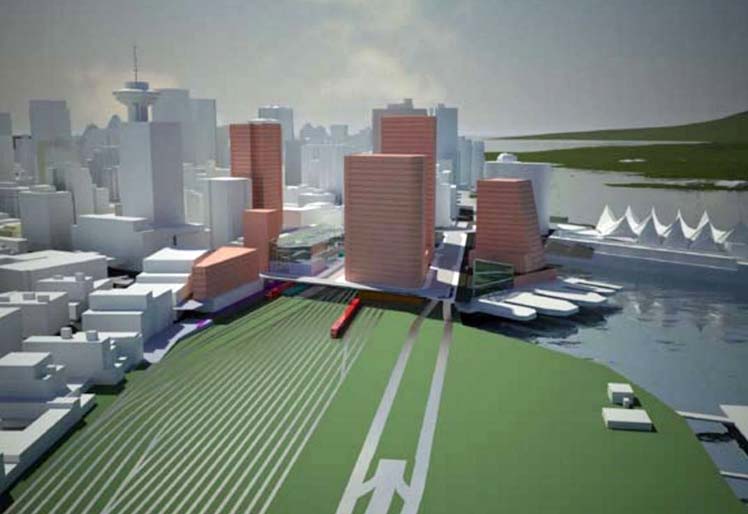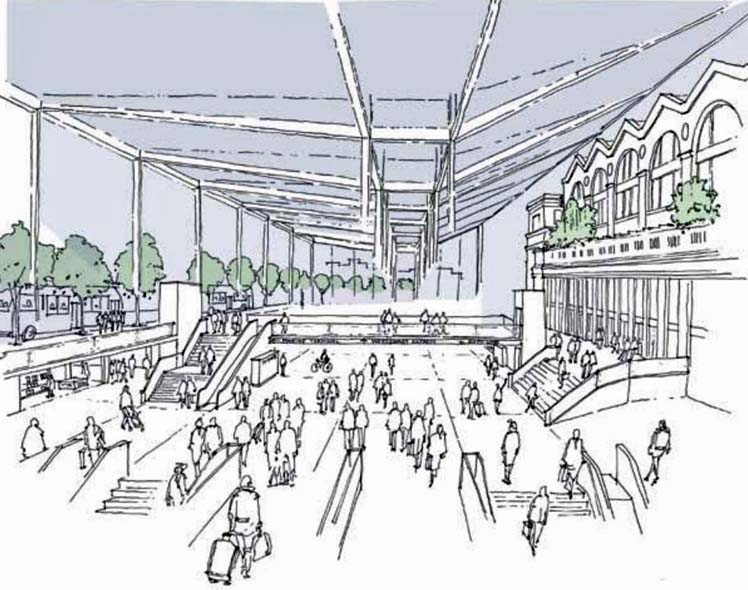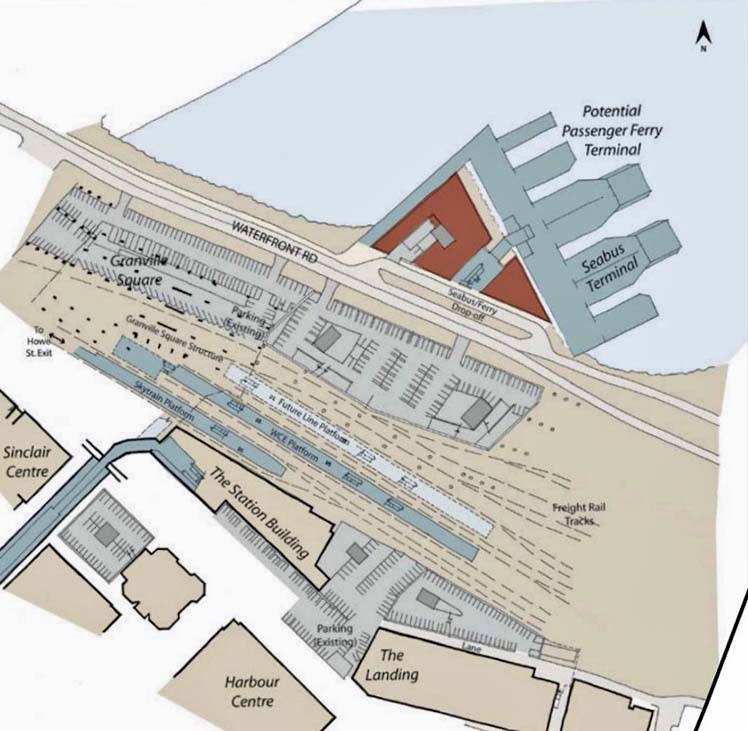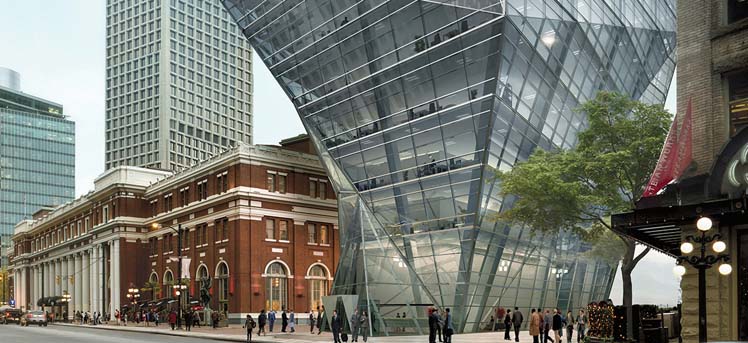
area in downtown Vancouver - Date/Artist unknown.
Vancouver British Columbia - Every global city has a "big city," multi-modal transportation hub.
New York City has Grand Central Station, London has Waterloo Station, Berlin has the Hauptbahnhof, and Toronto has Union Station, which is currently undergoing
a years-long, $800 million retrofit that expands the downtown Toronto transit hub's capacity and retail and amenity options.
Metro Vancouver's equivalent of these station hubs is downtown Vancouver's Waterfront Station, where two SkyTrain lines, the West Coast Express, SeaBus, and
several major bus routes converge.
And almost exactly a decade ago, Vancouver City Council approved a long-term plan, the Central Waterfront Hub Framework (CWHF), for transforming this station
into a world-class hub and building new dense commercial developments and public spaces from the station building to the water.
This also includes extending the street network over the rail yard, with new street viaducts extending into the area north of the station from Canada Place
Way, Granville Street, and Cordova Street.
"The potential exists to physically reconnect the city to the waterfront in this area and introduce new commercial and mixed use development which would
expand downtown job space capacity in a location with unparalleled transit accessibility," reads the plan approved in 2009.
The planning process was launched in 2007 due to a desire to create a comprehensive waterfront plan, after the Vancouver Whitecaps proposed to fund and build a
15,000 to 30,000 seat outdoor stadium on a waterfront rail yard air parcel owned by club-owner Greg Kerfoot, but technical difficulties with this plan led to
discussions with the Port of Vancouver on building a stadium in the area of the SeaBus terminal.
These new stadium plans have since been put on hold, as the Whitecaps have committed themselves to BC Place Stadium.
The City of Vancouver currently has no plans to revisit and implement the CWHF anytime soon, given that the municipality is preoccupied with a number of other
projects and priorities, including the redevelopments and viaduct removals in Northeast False Creek (NEFC).
"The City and the Port have ongoing discussions on the area, but there are no near-term plans to kickoff a process towards further design and
implementation at this time," city planners told Daily Hive in an email.
The last time the CWHF was mentioned was in the region's recent bid for Amazon HQ2, which identified the significant office space that would be generated by
CWHF as one of the possible locations for some of the Amazon headquarters office buildings in downtown Vancouver.
Major improvements to Waterfront Station are also not identified as a priority regional project in TransLink's Mayors' Council vision.
TransLink spokesperson Jill Drews said the public transit authority is currently in the process of consulting on its Regional Transportation Strategy, and is
encouraging the public and local leaders to submit ideas like this.
"Getting plans like this in the Regional Transportation Strategy is the first step toward getting a project like this off the ground," she
said.
While the city has spearheaded NEFC on its own, with the $1.7 billion project largely financed by the new private residential developments in the area, new
private commercial developments generated in the CWHF would likely be insufficient to cover the costs of the new viaduct street infrastructure required to
service the new development sites north of the station.
The last time a viaduct was extended in the area was more than a decade ago, when Canada Place Way was extended between Burrard Street and Thurlow
Street.
But this project was funded by the provincial government to allow for the construction of the West Building of the Vancouver Convention Centre.
Here are the plans for the area around Waterfront Station, as outlined by the CWHF:
New Glass Covered Transit Concourse at Waterfront Station

Waterfront Station would become an enhanced, landmark transit interchange with the construction of a "grand new passenger concourse" with a
high-ceiling, expansive glass roof.
This is intended to be a northwards expansion of the historic Canadian Pacific Railway (CP) building's concourse, over the existing Expo Line and West Coast
Express platforms.
Not only would this significantly increase the station's capacity and improve convenience and connectivity between the various transit services, the expanded
station would offer a wide-range of high-quality facilities and amenities such as retail, cafes, and restaurants, comfortable waiting areas, travel and tourist
information, public washrooms, bike storage, and secure luggage storage.
There could also be opportunities to directly connect passengers between the Canada Line and Expo Line platforms.
The plan also notes that the concourse size and location should enable the provision of at least one additional passenger rail platform, for an additional
SkyTrain or commuter rail line, to the north of the West Coast Express platform, including escalators, stairs, and elevator access to the
concourse.
"A new transit concourse should form the focal point of the Land Terminal, complementing and enhancing the functions of the existing Station Building
hall. The concourse should be an impressive urban space with a wide range of facilities and amenities for transit users and the public as a whole," reads
the plan.

in downtown Vancouver - Date/Artist unknown.

Waterfront Station - Date/Artist unknown.
New Marine Transit Terminal for SeaBus and Long-Haul Ferries
An underground pedestrian corridor below street level but above the rail yard would connect passengers to a new marine transit terminal for multiple services,
including the SeaBus and future long-haul passenger ferry operations to Nanaimo, Victoria, and Seattle.
Facilities and amenities in this marine terminal would include waiting areas, shops, and cafes, and perhaps even immigration control for ferry routes to the
United States.
The existing heliport in the area could potentially be integrated with the marine terminal.
Furthermore, the marine terminal and the Canada Place Way extension would provide new attractive public spaces to bring people closer to the water and enable
them to enjoy the views.
Office Space, Hotels, Retail, and Public Spaces
No residential use will be permitted on the new development sites created by the extension of the street network over the rail yard.
Only office space, hotels, retail, restaurants, and pubs, and other commercial services are allowed, and when coupled with well-designed public spaces,
including a large outdoor plaza suitable for major events, a vibrant waterfront district would be created.
A decade ago, the city indicated up to about 1.44 million square feet of floor space could be built within this area, but these allowance numbers are now
likely more on the conservative end given the municipal government's increasing propensity over time to allow for further density around major transit
stations.
With that said, earlier this decade, Cadillac Fairview proposed to build a 26 storey, origami-shaped office tower (555 West Cordova Street) on the ground-level
parking lot site between the CP building and Steamworks, but the project was sent back to the drawing board due to its size, far larger than what was outlined
in the CWHF, and especially its visual impact to the historic buildings in the area, especially the CP building.

Cordova Street - Date unknown Adrian Smith and Gordon Gill.
The federal government is also contemplating adding as much as 1.1 million square feet of office space to its historic Sinclair Centre property, up from the
existing heritage floor area of 390,000 square feet.
But the most significant obstacle to these developments north of the station will likely deal with the challenges of building over the rail yard and the Port's
growing rail capacity needs from increased container traffic.
Structural elements for the viaducts and new buildings over the rail yard will require the realignment of some of the rail yard tracks, which supports the
container operations at the nearby Centerm and Vanterm container terminals.
"CP and the Port have indicated that the freight rail functions of the yard will be required for the foreseeable future and may need to be expanded over
time to keep pace with growth in container traffic at the terminals," reads the plan.
"The City recognizes the importance of the CP yard to the container terminals and therefore to the city, regional, and Canadian economies, as well as the
efficiency and environmental benefits of transporting goods by rail."
Long-term plans are seldom absolutely concrete, perhaps these spaces could include another major expansion of the convention centre, should there be sufficient
demand and a desire to do so.
In the late-1990s, the municipal government shot down a proposal by one of Las Vegas' largest casino operators to build a Vegas-sized casino and hotel resort
with a privately-funded convention centre north of the station in the area of the SeaBus terminal.
The provincial government also previously seriously considered using this site for a publicly-funded convention centre expansion, before finally settling on
the Burrard Landing location to the west of Canada Place.
Kenneth Chan.
provisions in Section 29 of the Canadian
Copyright Modernization Act.

